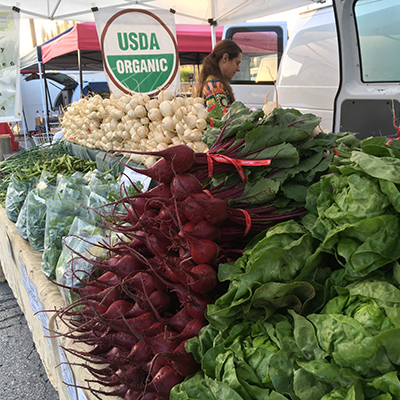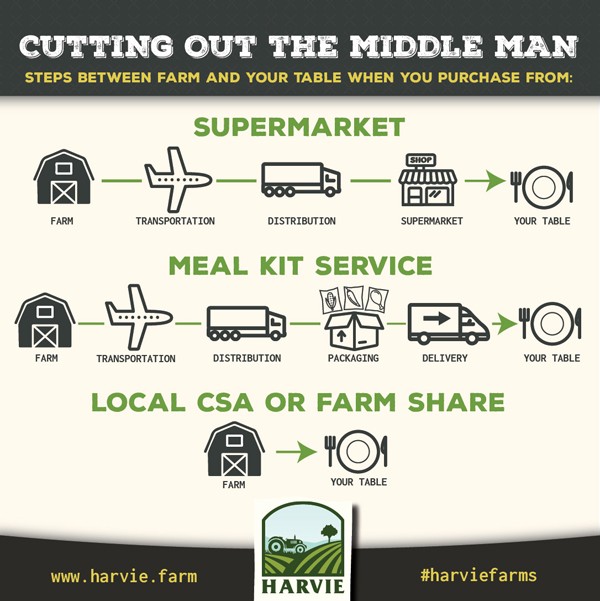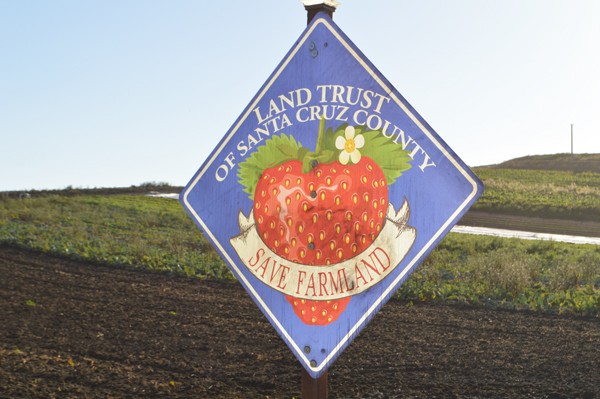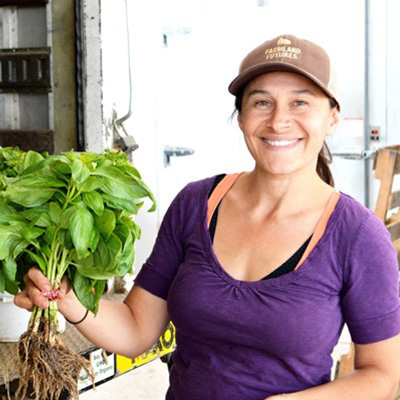BeetClock works with Wiswall’s workbook
Are you really making money on beans sold at a wholesale price once the pickers are paid? Even if you are on the first picking, are they still worth harvesting on the second picking?
There’s a new smartphone app called BeetClock that turns your phone into a powerful farm data collection device and can help you answer questions like these.
It’s important to know whether you’re making money on a crop and appearances can be deceiving. Just because you’re selling something for the same price as everyone else doesn’t mean you’re making a profit.
The difficulty of accurately calculating the amount of labor invested in a crop is a barrier to developing realistic crop budgets. Work may be split between any number of workers doing multiple jobs on different crops throughout the day. BeetClock was developed by Alex Smith, farm manager at Living Hope Farm in Harleysville, Pennsylvania, to simplify keeping track of the labor investment in a crop.
Below: screen shots from the BeetClock app. The image on the left shows a feature that allows you to add tractors and implements to track equipment usage time. The image on the right shows the timer function. Images courtesy of BeetClock.

Smith worked with Richard Wiswall, author of The Organic Farmer’s Business Handbook (available from www.growingformarket.com), on integrating the data from BeetClock into a free crop budgeting spreadsheet developed by Wiswall.
“Alex and I have been working on a way to tackle the most difficult issue in determining crop costs of production: how to record hours during the busy season, so that accurate info can be used in crop budgets,” Wiswall said.
Instead of having to keep paper records of what was done and how much time it took throughout the day, BeetClock simplifies the process with a time clock that can track the hours of multiple workers as they are working. For example, you can start the timer when three people start picking, and when they finish two hours later it will show six total hours of picking labor for that crop. Data can also be entered after the job is over if you didn’t track it as it was happening.
One of the other barriers to useful data collection is having to enter the data. Even if you go to the trouble of keeping accurate records, it takes precious time to put them into a computer. At the height of the season when everything is screaming for attention, it’s hard to find the time for sit down at the computer. But it doesn’t do you much good to know that you lost money harvesting peas three months ago.
Having the data entered as soon as it’s taken can help you make decisions based on data in real time. Smartphones are misnamed- really they are pocket computers that can make phone calls. They are of particular benefit for people who can’t spend a lot of time in the office but need good information like farmers. If you are walking around with a smartphone anyway, you can cut out the second step of sitting down at a desktop computer to enter the data.
“Smartphones are an integral part of modern farming, and this app nails a critical need,” said Wiswall.
An example of using BeetClock for real-time decision making came from Smith himself. I talked to him on a warm evening in mid-June after a busy day on the farm. When I asked him if he had been using Beetclock, he said he used it that day to decide whether to keep harvesting the strawberry patch or not. He was able to get the number of hours that were invested in harvesting from Beetclock and compare that to the amount of berries harvested. He used those numbers to decide whether the patch was still productive enough to keep harvesting, or whether it was costing more to pick than it was producing.
The information gathered by BeetClock can be viewed as a simple spreadsheet or it can be loaded straight into the NOFA Enterprise Analysis Workbook developed by Wiswall, which is available for free. This means you don’t have to go to the trouble of making your own crop budgets from scratch. You can benefit from Wiswall’s decades of experience in small farm economics by using the template he developed for your crop budget, which will help determine net profit per crop.
BeetClock is now available for $4 to download for Android operating systems at www.beetclock.com.
You can get a free download of the NOFA Enterprise Analysis Workbook at
http://beetclock.com/NOFA-Enterprise-Analysis-Workbook.php.
Free CSA app funded by Western SARE
by Becky Brown
On a fall day in October 2015, Maud Powell and her 12-year-old son Sam help pack boxes of produce for the over 200 members of the Siskiyou Sustainable Cooperative CSA in the Rogue Valley of southern Oregon. Beets, onions, cabbage, peppers and winter squash get added to the boxes assembly line style and Sam walks around with a clipboard double-checking the specialty items such as cheese, bread and beef that certain members have ordered that week.
As both a farmer and the coordinator for the CSA, now in its 15th year, Maud has seen the CSA movement shift and change to meet the demands of an increasingly diverse local food market. “The biggest challenge for CSA farmers today is staying relevant,” says Powell. “The abundance of natural grocers, farmers markets, farm stands and online distributors available in our area keep us on our toes.” As it becomes easier for consumers to buy local produce, CSA farmers are challenged to set themselves apart.

In addition to an online subscription and ordering system implemented four years ago (www.farmigo.com) Powell and a few other Co-op farmers came up with the idea for a CSA app during a marketing committee meeting two years ago. “The focus of the meeting was how to appeal to members who embrace the fast moving technology trends,” says Powell. With smartphone usage becoming the norm, they figured they could appeal to those looking for innovative and easy ways to enhance their cooking and eating experience with a mobile friendly tool at their fingertips.
Two years in the making and funded by a grant from Western SARE (Sustainable Agriculture Research and Education) the Co-op recently unveiled their new member app. “We are really happy with it. Members love the convenience of looking up storage tips and recipes from their smart phones and we love being able to provide such a slick and useful tool as an added bonus of their CSA membership,” boasts Powell.
But it doesn’t stop there. The SARE funds were secured so that other farmers would have access to the tool as well. This unique technology is available at no cost to any CSA farmer looking for another way to connect with their members. This innovative, open source software was created for the Siskiyou Sustainable Coop with all CSA farms in mind. “Farmers have enough to do,” explains Powell. “We wanted to provide a useful, easy tool that could benefit farmers anywhere in the world.”
In the development phase, Siskiyou Sustainable Cooperative CSA members participated in surveys and focus groups to determine the features and functionality that would be used in the app. The mobile friendly app was created using a web-based platform and is easily customizable by anyone comfortable using a computer and navigating the Internet. “The whole idea is to keep it simple for the farmer and easy to use for the membership,” says Powell. "We wanted to help make CSAs accessible for younger generations, and the most obvious way to do that is through the use of technology."
CSA farmers can utilize the templates in the web platform to create their very own personalized CSA app that includes product information and photos, recipes, cooking videos, cooking and storage tips, nutritional information, farmer bios and instructions for how and where to pick up weekly CSA box deliveries. Setting up the platform takes about 45 minutes for the average person who is comfortable navigating the web. Additional customization of CSA farm specific content could take as little as a few hours if your product list is similar to that used in the template. Additional customizations and added features can take several more hours depending upon the needs of the farm. Farmers who don’t have the time or computer skills could always seek out an intern or volunteer to set it up for them.
The CSA app can be useful in providing information to members via the web for farms that do not already have a website. The platform was designed specifically to be mobile friendly for use on smartphones and tablets, but is also suitable for desktop viewing. The app can be linked to CSA management software and ordering platforms such as Farmigo so that members can access their subscription accounts to make payments or put a box on hold from within the app. For CSA farms with an existing website the app can add mobile access for members.
CSA member Heidi from Ashland, Oregon finds the new app useful. “Like a lot of people these days, my smartphone has become an important organizational tool for my busy life. Having access to recipes and cooking videos that feature the same vegetables that I am picking up each week throughout the season makes my life a lot simpler.”
CSA members tend to cook and shop around what comes in their weekly box of produce. “I’m much more likely to eat what’s in my CSA share if I can find quick and easy ways to prepare meals that my whole family will enjoy. The new CSA app helps me do that,” reports Heidi.
Access to the customizable web platform is provided free of charge, although a valid credit card is required to secure information in the account set up phase. All content (product information, photos, recipes and more) was developed by the Siskiyou Sustainable Cooperative CSA in Jacksonville, Oregon and is open source and available for use, although individual customization may be necessary to reflect the specifics of a particular CSA farm.
At a recent Small Farms conference in Corvallis, OR, Powell and her team rolled out the new CSA app to a crowd of nearly 200. CSA farmers clamored for the chance to beta test the new software. “We’re thrilled at the response,” says Powell. “For some, this tool may be a stretch. There are plenty of CSA farmers who will not want to spend time in front of a computer or who may feel like adding one more thing to manage is impossible. But others are excited. Anything we can do to keep up with the latest trends will give us an advantage.”
As the boxes are loaded into the refrigerated truck at packout and Powell’s husband drives away to make deliveries, Maud pulls out her phone and clicks on the CSA app to update the “What’s in Your Box” list for the membership this week. “It’s pretty cool,” Powell smiles and Sam nods in agreement.
For more information and instructions on how to get started, please visit: http://www.siskiyoucoop.com/.
Becky Brown is a copywriter and owner of iWrite, providing small businesses with effective marketing communications, www.iwriteforbusiness.com. She has been a CSA member for 17 years and lives in Ashland, Oregon where she has finally learned to love beets.




 It’s not too late for online/preorder seedling sales, farmers market custom bags, and We Give a Share
It’s not too late for online/preorder seedling sales, farmers market custom bags, and We Give a Share
 Farmer to Farmer Profile
Farmer to Farmer Profile
 Why is the flower micro-farm best suited to a laser focus on one or two enterprises versus a balance of several? It is because of the long maturity of flower crops and the specific and conflicting demands of different types of flower enterprises. For example, some of the most common ways for farms to sell their flowers are at a farmers market, wholesale, from a flower stand/truck, a CSA, and weddings/events. These outlets can be compared on their need for similar types and quantities of flowers.
Why is the flower micro-farm best suited to a laser focus on one or two enterprises versus a balance of several? It is because of the long maturity of flower crops and the specific and conflicting demands of different types of flower enterprises. For example, some of the most common ways for farms to sell their flowers are at a farmers market, wholesale, from a flower stand/truck, a CSA, and weddings/events. These outlets can be compared on their need for similar types and quantities of flowers.



 For most established growers, the easiest place to start selling flowers will be mixed bouquets and single stem/small bunch retail sales. These are the flowers you can sell to your existing customers and they are easy to incorporate into farmers market, CSA, and grocery sales. But there are lots of other outlets out there, including florists, weddings and events, business subscriptions, value added products, and wholesalers.
For most established growers, the easiest place to start selling flowers will be mixed bouquets and single stem/small bunch retail sales. These are the flowers you can sell to your existing customers and they are easy to incorporate into farmers market, CSA, and grocery sales. But there are lots of other outlets out there, including florists, weddings and events, business subscriptions, value added products, and wholesalers.
 I made a trek out to Wisconsin in June. I’ve been lucky enough to visit this gorgeous state a few times, and I was glad to return. Wisconsin is the state with the second most organic acres in the country, behind California. It’s been an important crucible for the organic ag movement since the beginning. Out of the 177 of Chris Blanchard’s Farmer to Farmer podcasts, 21 featured Wisconsin-based businesses. From that list I chose two farms to visit and interview for this column.
I made a trek out to Wisconsin in June. I’ve been lucky enough to visit this gorgeous state a few times, and I was glad to return. Wisconsin is the state with the second most organic acres in the country, behind California. It’s been an important crucible for the organic ag movement since the beginning. Out of the 177 of Chris Blanchard’s Farmer to Farmer podcasts, 21 featured Wisconsin-based businesses. From that list I chose two farms to visit and interview for this column. 
 “CSA is dead” is a refrain I have heard from multiple farms in the past few years. I started to hear rumblings of a problem with the CSA model in 2014 through the CSA Farmer Discussion group that I manage on Facebook which brings together over 2,500 CSA farmers from all over the world. Farmers reported that they were having trouble attracting and retaining membership.
“CSA is dead” is a refrain I have heard from multiple farms in the past few years. I started to hear rumblings of a problem with the CSA model in 2014 through the CSA Farmer Discussion group that I manage on Facebook which brings together over 2,500 CSA farmers from all over the world. Farmers reported that they were having trouble attracting and retaining membership..jpg)
 It’s an incredibly cool, clear and dry July day in Massachusetts as I make my way to Brookfield Farm. Dan has arranged for me to visit at 2PM on a Thursday so I can see this bustling CSA farm at distribution time. I arrive just before the appointed hour, and see the last details of the setup being handled by apprentice Ellen. Dan and Karen are bustling around the corner, checking that the room is ready for the deluge of customers to come.
It’s an incredibly cool, clear and dry July day in Massachusetts as I make my way to Brookfield Farm. Dan has arranged for me to visit at 2PM on a Thursday so I can see this bustling CSA farm at distribution time. I arrive just before the appointed hour, and see the last details of the setup being handled by apprentice Ellen. Dan and Karen are bustling around the corner, checking that the room is ready for the deluge of customers to come. 
 Getting to High Ground Organics means going through the belly of the beast of California’s agricultural sweet spot – the Central Coast. This is where high value crops are grown right to the property line, right next to towns and suburbs, cheek by jowl. The proximity to the Pacific Ocean mitigates the climate of this region so it’s never that hot and never that cold; they can grow and harvest strawberries from March to October.
Getting to High Ground Organics means going through the belly of the beast of California’s agricultural sweet spot – the Central Coast. This is where high value crops are grown right to the property line, right next to towns and suburbs, cheek by jowl. The proximity to the Pacific Ocean mitigates the climate of this region so it’s never that hot and never that cold; they can grow and harvest strawberries from March to October. 
 Fifth Crow Farm lies nestled below some ragged hills – the native grass fully brown, the oaks wide and green. The farm grows 50 acres of certified organic crops on 150 acres of leased land, including vegetables, cut flowers, dry beans and eggs. The farm land is completely flat, tucked in a tiny valley in zone 9B. Believe it or not, just across the street, a mere two miles from the ocean, there are acres and acres of open land with cows grazing. How can land so close to such beauty, and with such a wonderful growing season be devoid of development? The answer is complicated, but mostly it’s because the parcels of land have always been quite large, and much of it is being purchased for conservation purposes.
Fifth Crow Farm lies nestled below some ragged hills – the native grass fully brown, the oaks wide and green. The farm grows 50 acres of certified organic crops on 150 acres of leased land, including vegetables, cut flowers, dry beans and eggs. The farm land is completely flat, tucked in a tiny valley in zone 9B. Believe it or not, just across the street, a mere two miles from the ocean, there are acres and acres of open land with cows grazing. How can land so close to such beauty, and with such a wonderful growing season be devoid of development? The answer is complicated, but mostly it’s because the parcels of land have always been quite large, and much of it is being purchased for conservation purposes.
 For years, my wife and I have been considering offering a winter CSA, but have been hesitant. This hesitation stemmed mostly from not having any real experience growing over winter (beyond the kale and collards that persist until January in our fields), but also from lacking the proper infrastructure. This year, however, with two small tunnels up and some decent storage facilities, we decided to make the leap. But I first wanted to talk to a few winter growers to see how they run their winter CSAs to get some pointers on what to expect, what to plan for, and how to manage everything from the hoophouse to the wash/pack. Here is what I learned.
For years, my wife and I have been considering offering a winter CSA, but have been hesitant. This hesitation stemmed mostly from not having any real experience growing over winter (beyond the kale and collards that persist until January in our fields), but also from lacking the proper infrastructure. This year, however, with two small tunnels up and some decent storage facilities, we decided to make the leap. But I first wanted to talk to a few winter growers to see how they run their winter CSAs to get some pointers on what to expect, what to plan for, and how to manage everything from the hoophouse to the wash/pack. Here is what I learned.
